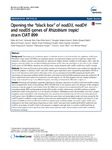Please use this identifier to cite or link to this item:
http://www.alice.cnptia.embrapa.br/alice/handle/doc/1039242Full metadata record
| DC Field | Value | Language |
|---|---|---|
| dc.contributor.author | CERRO, P. del | pt_BR |
| dc.contributor.author | ROLLA-SANTOS, A. A. P. | pt_BR |
| dc.contributor.author | GOMES, D. F. | pt_BR |
| dc.contributor.author | MARKS, B. B. | pt_BR |
| dc.contributor.author | ESPUNY, M. del R. | pt_BR |
| dc.contributor.author | RODRÍGUEZ-CARVAJAL, M. A. | pt_BR |
| dc.contributor.author | SORIA-DÍAZ, M. E. | pt_BR |
| dc.contributor.author | NAKATANI, A. S. | pt_BR |
| dc.contributor.author | HUNGRIA, M. | pt_BR |
| dc.contributor.author | JAVIER OLLERO, F. | pt_BR |
| dc.contributor.author | MEGÍAS, M. | pt_BR |
| dc.date.accessioned | 2016-03-01T11:11:11Z | pt_BR |
| dc.date.available | 2016-03-01T11:11:11Z | pt_BR |
| dc.date.created | 2016-03-01 | pt_BR |
| dc.date.issued | 2015 | pt_BR |
| dc.identifier.citation | BMC Genomics, v. 16, n. 1, p. 864, Oct. 2015. | pt_BR |
| dc.identifier.issn | 1471-2164 | pt_BR |
| dc.identifier.uri | http://www.alice.cnptia.embrapa.br/alice/handle/doc/1039242 | pt_BR |
| dc.description | Transcription of nodulation genes in rhizobial species is orchestrated by the regulatory nodD gene. Rhizobium tropici strain CIAT 899 is an intriguing species in possessing features such as broad host range, high tolerance of abiotic stresses and, especially, by carrying the highest known number of nodD genes?five?and the greatest diversity of Nod factors (lipochitooligosaccharides, LCOs). Here we shed light on the roles of the multiple nodD genes of CIAT 899 by reporting, for the first time, results obtained with nodD3, nodD4 and nodD5 mutants. The three nodD mutants were built by insertion of ? interposon. Nod factors were purified and identified by LC-MS/MS analyses. In addition, nodD1 and nodC relative gene expressions were measured by quantitative RT-PCR in the wt and derivative mutant strains. Phenotypic traits such as exopolysaccharide (EPS), lipopolysaccharide (LPS), swimming and swarming motilities, biofilm formation and indole acetid acid (IAA) production were also perfomed. All these experiments were carried out in presence of both inducers of CIAT 899, apigenin and salt. Finally, nodulation assays were evaluated in up to six different legumes, including common bean (Phaseolus vulgaris L.). Phenotypic and symbiotic properties, Nod factors and gene expression of nodD3, nodD4 and nodD5 mutants were compared with those of the wild-type (WT) CIAT 899, both in the presence and in the absence of the nod-geneinducing molecule apigenin and of saline stress. No differences between the mutants and the WT were observed in exopolysaccharide (EPS) and lipopolysaccharide (LPS) profiles, motility, indole acetic acid (IAA) synthesis or biofilm production, either in the presence, or in the absence of inducers. Nodulation studies demonstrated the most complex regulatory system described so far, requiring from one (Leucaena leucocephala, Lotus burtii) to four (Lotus japonicus) nodD genes. Up to 38 different structures of Nod factors were detected, being higher under salt stress, except for the nodD5 mutant; in addition, a high number of structures was synthesized by the nodD4 mutant in the absence of any inducer. Probable activator (nodD3 and nodD5) or repressor roles (nodD4), possibly via nodD1 and/or nodD2, were attributed to the three nodD genes. Expression of nodC, nodD1 and each nodD studied by RT-qPCR confirmed that nodD3 is an activator of nodD1, both in the presence of apigenin and salt stress. In contrast, nodD4 might be an inducer with apigenin and a repressor under saline stress, whereas nodD5 was an inducer under both conditions. | pt_BR |
| dc.language.iso | eng | eng |
| dc.rights | openAccess | eng |
| dc.title | Opening the "black box" of nodD3, nodD4 and nodD5 genes of Rhizobium tropici strain CIAT 899. | pt_BR |
| dc.type | Artigo de periódico | pt_BR |
| dc.date.updated | 2017-06-19T11:11:11Z | pt_BR |
| dc.subject.thesagro | Rhizobium | pt_BR |
| dc.subject.thesagro | Fixação de nitrogênio | pt_BR |
| dc.subject.thesagro | Bacteriologia do solo | pt_BR |
| dc.subject.thesagro | Nodulação | pt_BR |
| dc.subject.nalthesaurus | Bacteriology | pt_BR |
| dc.subject.nalthesaurus | Nitrogen fixation | pt_BR |
| dc.subject.nalthesaurus | Nodulation | pt_BR |
| riaa.ainfo.id | 1039242 | pt_BR |
| riaa.ainfo.lastupdate | 2017-06-19 | pt_BR |
| dc.identifier.doi | 10.1186/s12864-015-2033-z | pt_BR |
| dc.contributor.institution | PABLO DEL CERRO, Universidad de Sevilla; AMANDA ALVES PAIVA ROLLA-SANTOS; DOUGLAS FABIANO GOMES; BETTINA BERQUÓ MARKS; MARÍA DEL ROSARIO ESPUNY, Universidad de Sevilla; MIGUEL ÁNGEL RODRÍGUEZ-CARVAJAL, Universidad de Sevilla; MARÍA EUGENIA SORIA-DÍAZ, CITIUS; ANDRÉ SHIGUEYOSHI NAKATAN; MARIANGELA HUNGRIA DA CUNHA, CNPSO; FRANCISCO JAVIER OLLERO; MANUEL MEGÍAS. | pt_BR |
| Appears in Collections: | Artigo em periódico indexado (CNPSO)  | |
Files in This Item:
| File | Description | Size | Format | |
|---|---|---|---|---|
| 128642015Article2033.pdf | 923,39 kB | Adobe PDF |  View/Open |








